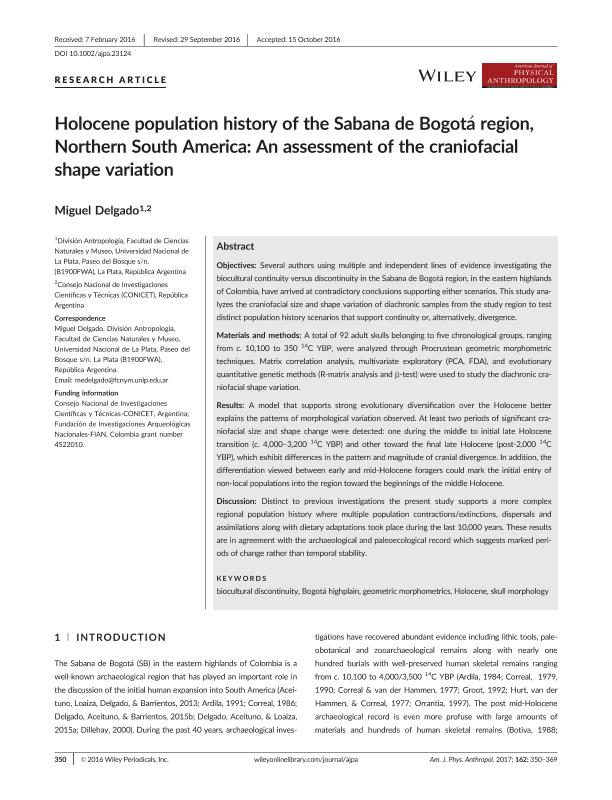Mostrar el registro sencillo del ítem
dc.contributor.author
Delgado Burbano, Miguel Eduardo

dc.date.available
2018-08-21T20:20:53Z
dc.date.issued
2017-02
dc.identifier.citation
Delgado Burbano, Miguel Eduardo; Holocene population history of the Sabana de Bogotá region, Northern South America: An assessment of the craniofacial shape variation; Wiley-liss, Div John Wiley & Sons Inc; American Journal Of Physical Anthropology; 162; 2; 2-2017; 350-369
dc.identifier.issn
0002-9483
dc.identifier.uri
http://hdl.handle.net/11336/56452
dc.description.abstract
Objectives: Several authors using multiple and independent lines of evidence investigating the biocultural continuity versus discontinuity in the Sabana de Bogotá region, in the eastern highlands of Colombia, have arrived at contradictory conclusions supporting either scenarios. This study analyzes the craniofacial size and shape variation of diachronic samples from the study region to test distinct population history scenarios that support continuity or, alternatively, divergence. Materials and methods: A total of 92 adult skulls belonging to five chronological groups, ranging from c. 10,100 to 350 14C YBP, were analyzed through Procrustean geometric morphometric techniques. Matrix correlation analysis, multivariate exploratory (PCA, FDA), and evolutionary quantitative genetic methods (R-matrix analysis and β-test) were used to study the diachronic craniofacial shape variation. Results: A model that supports strong evolutionary diversification over the Holocene better explains the patterns of morphological variation observed. At least two periods of significant craniofacial size and shape change were detected: one during the middle to initial late Holocene transition (c. 4,000–3,200 14C YBP) and other toward the final late Holocene (post-2,000 14C YBP), which exhibit differences in the pattern and magnitude of cranial divergence. In addition, the differentiation viewed between early and mid-Holocene foragers could mark the initial entry of non-local populations into the region toward the beginnings of the middle Holocene. Discussion: Distinct to previous investigations the present study supports a more complex regional population history where multiple population contractions/extinctions, dispersals and assimilations along with dietary adaptations took place during the last 10,000 years. These results are in agreement with the archaeological and paleoecological record which suggests marked periods of change rather than temporal stability.
dc.format
application/pdf
dc.language.iso
eng
dc.publisher
Wiley-liss, Div John Wiley & Sons Inc

dc.rights
info:eu-repo/semantics/openAccess
dc.rights.uri
https://creativecommons.org/licenses/by-nc-sa/2.5/ar/
dc.subject
Biocultural Discontinuity
dc.subject
BogotÁ Highplain
dc.subject
Geometric Morphometrics
dc.subject
Holocene
dc.subject
Skull Morphology
dc.subject.classification
Arqueología

dc.subject.classification
Historia y Arqueología

dc.subject.classification
HUMANIDADES

dc.title
Holocene population history of the Sabana de Bogotá region, Northern South America: An assessment of the craniofacial shape variation
dc.type
info:eu-repo/semantics/article
dc.type
info:ar-repo/semantics/artículo
dc.type
info:eu-repo/semantics/publishedVersion
dc.date.updated
2018-08-21T18:36:40Z
dc.journal.volume
162
dc.journal.number
2
dc.journal.pagination
350-369
dc.journal.pais
Estados Unidos

dc.journal.ciudad
Hoboken
dc.description.fil
Fil: Delgado Burbano, Miguel Eduardo. Universidad Nacional de La Plata. Facultad de Ciencias Naturales y Museo. Área Antropológica; Argentina. Consejo Nacional de Investigaciones Científicas y Técnicas; Argentina
dc.journal.title
American Journal Of Physical Anthropology

dc.relation.alternativeid
info:eu-repo/semantics/altIdentifier/doi/http://dx.doi.org/10.1002/ajpa.23124
dc.relation.alternativeid
info:eu-repo/semantics/altIdentifier/url/https://onlinelibrary.wiley.com/doi/abs/10.1002/ajpa.23124
Archivos asociados
